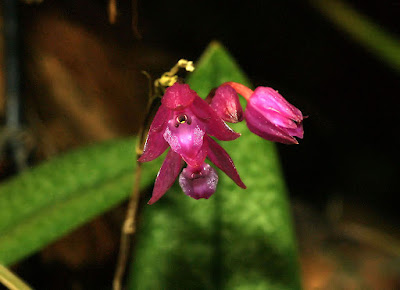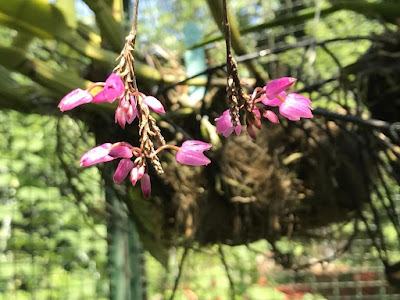Domingoa purpurea is native to Southwest Mexico and Central America, including Guatemala, Honduras, Nicaragua and El Salvador. They usually grow in pine and oak forests on rocky hills, up to a height of 1500 m...
Domingoa purpurea also called as Purple Domingoa, Nageliella purpurea, Hartwegia comosa, Hartwegia purpurea, is a species of the genus Domingoa. This species was described by Van den Berg & Soto Arenas in 2007.
IDENTIFY DOMINGOA PURPUREA
Domingoa purpurea is native to Southwest Mexico and Central America, including Guatemala, Honduras, Nicaragua and El Salvador. They usually grow in pine and oak forests on rocky hills, up to a height of 1500 m, on the slopes of mountains directed towards the Pacific. In Mexico, however, they are found in the states of Veracruz, Chiapas and Oaxaca, that is, on the Atlantic side of the continent. They grow there on horizontal branches of oaks in shallow moss and accumulated debris.
It is a small sized, cool to warm growing epiphytic species, which reaching a height of 5-20 cm, with slender, erect, pseudobulbous, clavate, 2-8 cm long stems carrying a basally clasping, lanceolate or ovate-lanceolate, acute or subacute, coriaceous, green, 3-12 cm long and 0.7-3.0 cm wide leaves that are spotted bronze-purple.
Purple Domingoa blooms in the summer and carries non-fragrant flowers. The cupped flowers are about 0.7 cm in diameter between the tips of the side outer petals. The dorsal petal is blunt ended, concave, elliptical, and faces forward, forming a cap over the backbone. The wide triangular lateral outer petals are 0.7-0.9 cm long and 0.3-0.5 cm wide. At the base they are connected, creating a distinct funnel. Elliptical-lanceolate petals of the inner whorl, slightly shorter than the petals of the outer whorl, with a width that is not even half the width of the outer petals, have tassels and tiny hairs along the banks. The petals of both whorls are more or less forward, giving the flowers a cupped shape. The lip and the rod are joined together to form a small pouch at the base.
DOMINGOA PURPUREA CARE AND CULTURE
Cultural information should only be used as a guide, and should be to be adapted to suit you. Your physical location; where you grow your plants, how much time you have to devote to their care, and many other factors, will need to be taken into account. Only then can you decide on the cultural methods that best suit you and your plants.
Light:
Domingoa purpurea needs a light level of 25000-35000 lux. The light should be filtered or dispersed, and the plants should not be exposed directly to the sun in the afternoon hours. Strong air movement should be ensured all the time.
Temperature:
It is a plant with moderate thermal requirements. The average summer temperature in the summer is 25 ° C, the average night is 15 ° C, which gives a daily amplitude of 10 ° C. The average winter temperature is 22-23 ° C during the day and 11-12 ° C at night, giving a diurnal difference of 10-12 ° C.
Humidity:
Purple Domingoa needs the humidity of 80-85% in summer and early autumn, decreasing in winter and spring to 70-75%.
Substrate, growing media and repotting:
Domingoa purpurea are usually grown in pots or baskets filled with loose, permeable ground that allows the roots to dry quickly after watering. You can use of small pots filled with tightly packed osmunda ferns, or use medium to thick bark as medium medium, usually mixed with perlite and charcoal, or use pieces of pumice with the top layer of fresh moss.
These plants can also be mounted on tree trunks, but they should be provided with high humidity, and during the summer they must be watered at least once a day. In the case of such suspended plants, during the dry and hot periods it may be necessary to water several times a day. Repotting or dividing the plant should be done only when the growth of new roots begins.
Watering:
In the period from late spring to autumn rainfall is moderate to heavy. Their quantity then drops sharply and follows a period of 5-6 months of drought lasting until the beginning of spring. During active growth, the plants should be abundantly watered. The roots must, however, quickly dry out after watering, so the substrate can never be desiccated or soaked. When new growths reach maturity in the autumn, the amount of water should be reduced.
Fertilizer:
During the active growth, the plants should be fertilized every week 1/4-1/2 of the recommended dose of fertilizer for orchids. A fertilizer with a high nitrogen content is beneficial from spring to mid-summer, and a fertilizer richer in phosphorus should be used in late summer and autumn.
Rest period:
In winter, watering for Domingoa purpurea should be limited, but must not be allowed to stay dry for a long time. Fertilization should be reduced or eliminated until new growths appear and a more abundant spring watering begins.

















COMMENTS